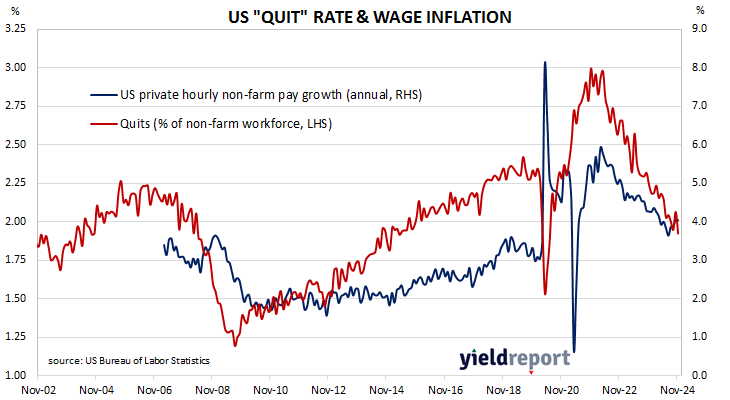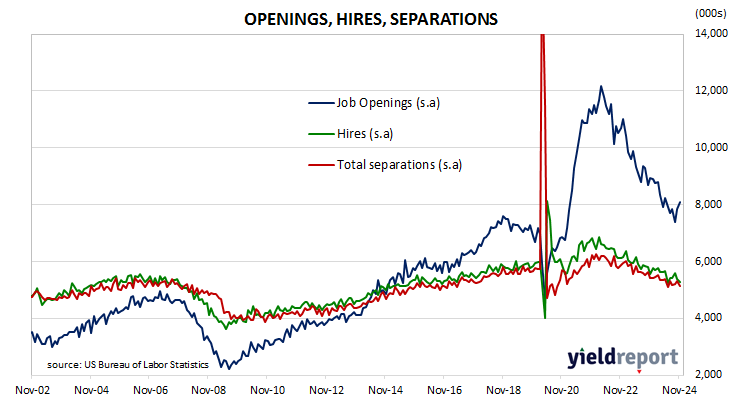Summary: US quit rate falls back in November; US Treasury yields rise; expectations of Fed rate cuts soften; fewer quits, more openings, fewer separations.
The number of US employees who quit their jobs as a percentage of total employment increased slowly but steadily after the GFC. It peaked in March 2019 and then tracked sideways until virus containment measures were introduced in March 2020. The quit rate then plummeted as alternative employment opportunities rapidly dried up. Following the easing of US pandemic restrictions, it proceeded to recover back to its pre-pandemic rate in the third quarter of 2020 and trended higher through 2021 before easing through 2022, 2023 and 2024.
Figures released as part of the latest Job Openings and Labor Turnover Survey (JOLTS) show the quit rate dropped in November after revisions. 1.9% of the non-farm workforce left their jobs voluntarily, down from 2.1% in October. Quits in the month increased by 218,000 while an additional 227,000 people were employed in non-farm sectors.
US Treasury bond yields rose almost uniformly across the curve on the day. By the close of business, the 2-year Treasury bond yield had gained 6bps to 4.30% while 10-year and 30-year yields both finished 7bps higher at 4.69% and 4.92% respectively.
In terms of US Fed policy, expectations of a lower federal funds rate in the next 12 months softened, although another 25bp cut is still fully priced in. At the close of business, contracts implied the effective federal funds rate would average 4.315% in February, 4.285% in March and 4.23% in April. December 2025 contracts implied 3.96%, 37bps less than the current rate.
The fall in total quits was led by 85,000 fewer resignations in the “Accommodation and food services” sector, the sector which led October’s rise, while the “Transportation, warehousing and utilities” sector experienced the largest increase, 26,000. Overall, the total number of quits for the month decreased from October’s revised figure of 3.283 million to 3.065 million.
Total vacancies at the end of November increased by 259,000, or 3.3%, from October’s revised figure of 7.839 million to 8.098 million. The increase was driven by 273,000 more open positions in the “Professional and business services” sector, while the “Accommodation and food services” sector experienced 102,000 fewer offerings, the largest decline by sector. Overall, 10 out of 18 sectors experienced more job openings than in the previous month.
Total separations decreased by 180,000, or 3.4%, from October’s revised figure of 5.306 million to 5.126 million. The fall was led by the “Professional and business services” sector where there were 60,000 fewer separations while the “Accommodation and food services” sector experienced 34,000 more separations. Separations increased in 12 of the 18 sectors.
The “quit” rate time series produced by the JOLTS report is a leading indicator of US hourly pay. As wages account for around 55% of a product’s or service’s price in the US, wage inflation and overall inflation rates tend to be closely related. Former Federal Reserve chief and current Treasury Secretary Janet Yellen was known to pay close attention to it.



